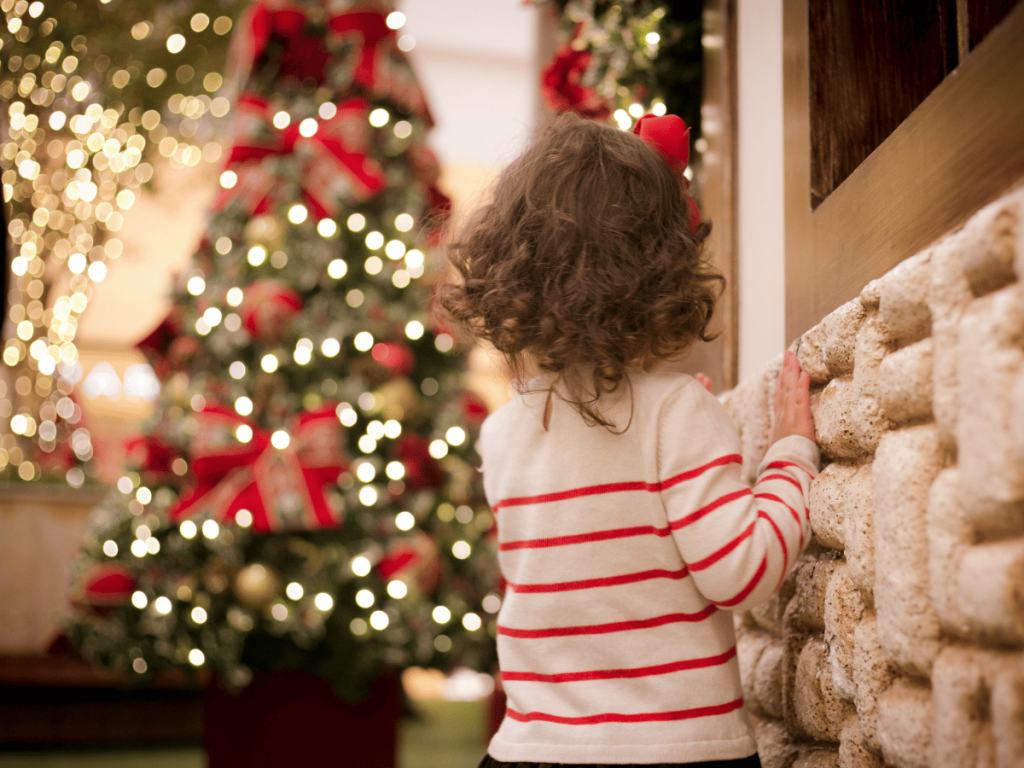
Essential Holiday Fire Safety for Kids
The holiday season brings joy, decorations, and family gatherings but also presents unique fire risks. Christmas lights, candles, and festive cooking add warmth to our celebrations yet can create hazards, especially with young children around.
At PuroClean Restoration Services, your family’s safety is our top priority. To help, we’ve created the “12 Days of Holiday Fire Safety.” Each tip is practical, simple, and perfect for sharing with children.
From checking smoke alarms to safe decorating and planning fire escapes, these tips help protect your home and keep your holidays bright. Gather the family and make holiday fire safety a tradition!
The Importance of Christmas Fire Safety
Winter holidays are peak times for home fires. Christmas and Christmas Eve are among the top days for a house fire, with Thanksgiving being the peak day for fires related to cooking.
According to information gathered from fire departments around the nation, house fires increase during the holidays, particularly those originating from Christmas trees and decorations.
- Christmas Day: Fires from cooking, lit wax candles, and holiday decorations are common. Candle fires are 2.5 times more likely on Christmas Day than on average, according to the National Fire Protection Association.
- Christmas Eve: This day has similar risks to Christmas Day, with added danger from holiday lights and Christmas trees.
By teaching children to understand fire risks and empowering them with simple fire-safety actions, you’re making the season safer for everyone. Fire-smart kids who know how to respond in an emergency can help prevent accidents, stay calm, and help others when needed.
12 Days of Holiday Fire Safety Tips
Day 1: Introduce a Safe Holiday Season Mindset
Kick off your family’s season of safety by talking to your kids about fire prevention basics. Explain that fires can be dangerous, and over the next 12 days, you’ll help them learn how to stay safe and what to do in case of a fire.
- Check Your Smoke Alarms Together
Start your family fire safety journey with a hands-on lesson. Check your smoke alarms as a family. Show your kids how to test the alarms, and let them hear the sound it makes so they’ll know what to expect in an emergency.
Day 2: Create a Family Fire Escape Plan
As a family, create a fire escape plan. Let everyone learn two ways out of each room and the house. Turn your fire plan into an adventure. Walk your children through the plan and practice escaping through different exits. Use markers to draw a map of your home with labeled escape routes, and let them decorate it. Hang it on the fridge as a reminder.
- Play “Stop, Drop, and Roll”
Make fire safety fun by practicing “Stop, Drop, and Roll” with your kids. Turn it into a game and see who can do it correctly and the fastest! This simple drill helps them remember what to do if their clothing ever catches fire.
Day 3: Christmas Trees – Selection and Set up
Picking out and setting up a Christmas tree together can be a joyful tradition, but home Christmas tree fires are common. Select your Christmas tree carefully. Use this opportunity to help your kids understand that trees need to be kept safe, too.
- Real Trees
Real Christmas trees can be a fire risk, especially if they dry out. Choose one with fresh, green needles that are hard to pull off. - Live Christmas Trees
If using a live tree in a pot, water it regularly and place it in a cool area. Live trees stay fresh longer but should still be kept away from heat sources to prevent drying out. - Artificial Trees
For an artificial tree, look for a “fire-resistant” label. Although these trees are generally safer, they can still ignite if near heat. - Safe Tree Location
Pay attention to where you put your tree. Keep it at least three feet away from all heat sources—fireplaces, heaters, radiators, candles, and heat vents. Position it securely to prevent tipping, especially with young children or pets around. Also, make sure it doesn’t block walkways or exits to ensure easy movement through your home.
Day 4: Key Christmas Tree Safety Tips
Christmas tree safety doesn’t stop after setup. Taking care of the Christmas tree is key to reducing holiday season fire risks.
- Use LED Indoor Lights
When decorating your tree together, choose LED lights labeled for indoor use. LED electric lights stay cool, which helps keep real trees from drying out as quickly. Avoid using outdoor lights on your tree, as they can generate more heat and increase fire risks. - Water Your Tree Daily
If you have a real tree (cut or live), water it every day. A well-watered tree stays fresh longer and is less likely to catch fire. Dry needles and branches ignite more quickly, so keeping your tree healthy is essential. - Safe Disposal
As Christmas trees dry out, they become more flammable. In fact, more than one-third of Christmas tree fires occur in January. Dispose of your tree after the holidays or when it dries out to avoid fire risk. Check with your local waste services for safe disposal options.
Christmas Safety Tips- PuroClean Restoration Cranford
Day 5: Holiday Lighting and Electrical Safety
Holiday lights add magic to your home but can be a fire hazard if not used properly. Nearly one out of three Christmas tree fires are caused by electrical issues, so practicing safe lighting habits is key.
- Light Safely
When stringing lights, avoid overloading electrical outlets and keep lights away from heat sources. Follow the instructions that come with the lights to know how many strands you can connect. If you need more lights than can be connected, plug the extra strands into a power strip to safely distribute the electrical load. - Check for Damage
Inspect light strings before you put them up. Make sure cords are in good condition. Look for frayed cords. Throw out light strands with frayed or crimped cords. Damaged lights can cause dangerous sparks and increase fire risks. - Unplug Lights Before Bed
Remember to unplug all holiday and tree lights before leaving the house or going to sleep. This simple habit reduces the risk of electrical fires.
Involve your kids by giving them a safety task, like reminding you to unplug the lights before bed or when leaving the house.
Day 6: Extension Cord Safety
Extension cords are handy during the holiday season but they can also be dangerous if not used carefully.
- Avoid Tripping and Fraying Hazards
Never run extension cords under rugs or across walkways. Cords under rugs can overheat, and they’re more likely to get damaged or fray over time. Keeping cords out of walkways also prevents tripping accidents. - Prevent Overloaded Outlets
Make sure not to overload any one outlet with too many plugs. If you plug too many devices into an outlet, you can overheat it and start a fire. - Don’t Daisy Chain Cords
Connecting—or “daisy-chaining”—multiple extension cords together may seem like a quick solution, but it’s unsafe. Instead, use a single, long extension cord or rearrange your decorations to avoid needing extra cords.
Do a “Show and Tell” with your kids by walking around the house together to check cord placements. Let them help spot cords in walkways or under rugs.
Read more about Extension Cord Safety Tips.
Day 7: Prevent Candle and Home Decoration Fires
Wax candles bring warmth and beauty to the holidays but are also a common fire hazard this time of year. Candle-related decoration fires increase significantly in December, so use them safely!
- Consider Battery-Powered Candles
For a safer alternative, use battery-operated flameless candles. Newer types create a cozy, flickering glow without any fire risk. - Keep Flammable Items Away
Always keep flammable items—like decorations, curtains, and paper—at least 3 feet away from candles. Place candles on non-flammable surfaces like ceramic or metal holders to prevent accidental fires. - Never Use Candles if Oxygen is Used in the Home.
Avoid using candles altogether if there’s an oxygen tank in your home. Oxygen makes fires spread much faster, even from a tiny spark. - Never Leave Candles Unattended
Blow out your candles before leaving the room or going to bed. Never leave a lit candle unattended, even for a moment. - Supervise Kids and Candles
Never leave a child alone in a room with lit candles. Also, keep matches and lighters up high and out of children’s reach.
Make “good night” a holiday safety ritual. Add blowing out candles or turning off lights to your nightly routine to keep your home safe and cozy.
Day 8: Fireplace Fire Prevention
A cozy fireplace adds warmth to the holidays, but fire safety is essential for safe enjoyment.
- Fully Extinguish Embers
Before bed, ensure all embers are completely out. Even small embers can spark overnight, so double-check that everything is fully extinguished. - Keep Flammables Away
Keep anything flammable—like wrapping paper, rugs, and clothing—at least three feet from the fireplace. This helps prevent stray sparks from igniting nearby items. - Use a Fireplace Screen
Always use a fire screen to keep embers and logs contained. Screens add an extra layer of protection, especially with kids and pets around. - Keep Fire Extinguishing Supplies Nearby
Have a fire extinguisher or a bucket of water handy. Being prepared makes it easier to contain small fires quickly.
Keep it cozy. While gathering by the fireplace, make it a family habit to look for items too close to the flames.
Day 9: Holiday Cooking Safety
The holiday season brings delicious aromas and family fun in the kitchen, but cooking safely is essential to keep it accident-free. Prevent kitchen fires with a few simple steps to ensure a safe and enjoyable time for the whole family while preparing holiday treats.
- Create a “Child-Free Zone”
Set up a “child-free zone” of at least three feet around the stove and oven. Explain to kids that this area is only for grown-ups when people are cooking. This keeps everyone safe from hot surfaces and spills. - Turn Pot Handles Inward
Always turn pot handles inward to avoid bumps and spills. This helps prevent accidents, from burns to fires. - Clean Up Greasy Spills
Grease buildup can start fires, so wiping up spills as you go is important. This makes cleanup quicker, too! - Follow Safety Guidelines: For added peace of mind, check out the National Fire Protection Association’s guidelines for safe cooking practices.
Let your children play a helpful role before you start cooking by having them spot any towels, utensils, or other fire hazards too close to the stove or oven. Make it a game to find these “sneaky items” and move them to safer spots.
Day 10: Space Heaters – Stay Safe While Staying Warm
Space heaters can keep your home cozy but they are potential fire risks. Using them safely is essential to prevent fires. Again, you can have your kids watch for and move things too close to the heat.
- Use Heaters with Automatic Shut-Offs
Choose heaters with an automatic shut-off feature. This safety setting turns the heater off if it tips over or overheats, helping to prevent accidents. - Proper Placement
Place heaters on stable, non-flammable surfaces, like hardwood floors, and avoid using them on rugs or carpets. Keep them away from anything flammable, like wrapping paper, curtains or furniture, and make sure they’re out of reach of young children and pets who might accidentally knock them over. - Follow Manufacturer’s Instructions
Always follow the manufacturer’s instructions for safe use. Proper setup and maintenance can make a big difference in keeping your heater safe.
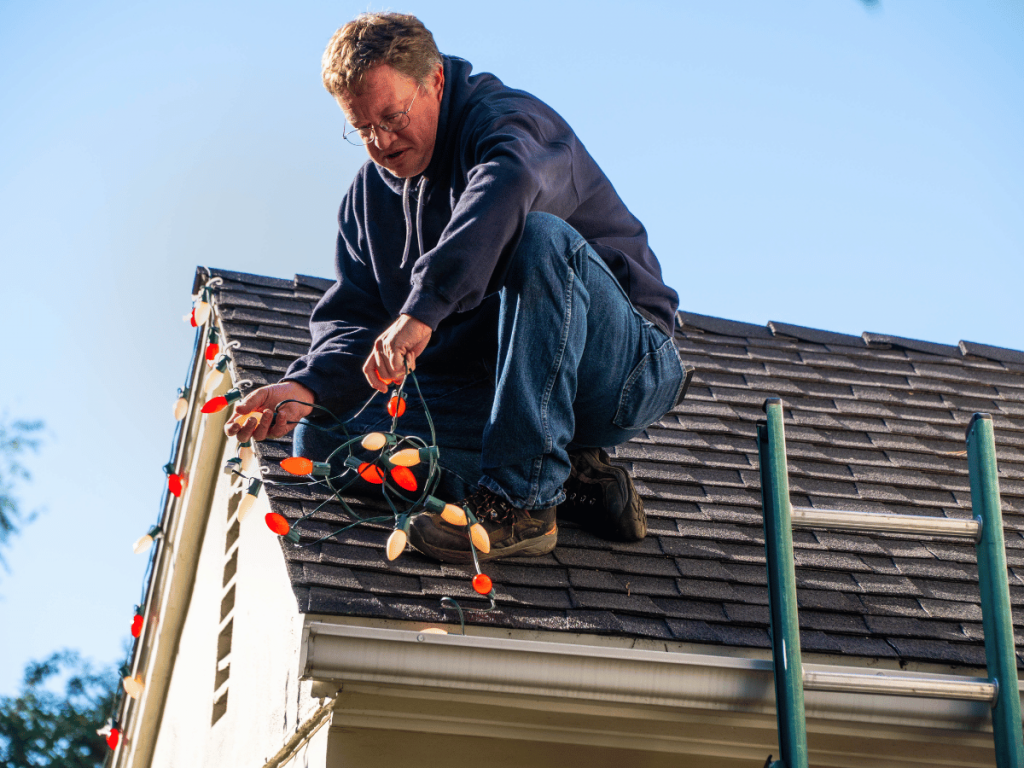
Day 11: Outside Lights and Electrical Decorations
Decorating outside adds festive cheer, but safely setting up outdoor lights and decorations is essential.
- Use Outdoor Christmas Lights and Electrical Decorations
Only use lights and decorations labeled for outdoor use. These lights are built to handle moisture and temperature changes, making them safer and more reliable outdoors. - Check for Frayed or Damaged Wires
Before decorating, check your light strands and cords for any signs of wear, fraying, or damage. Discard damaged items, as they can spark or short-circuit, causing fires. - Secure Lights Safely
Use insulated clips to secure lights to trees, your home, or other sturdy surfaces. Avoid nails or staples, which can damage the cords and create a fire hazard. - Be Cautious with Metal Ladders
When hanging lights, avoid using metal ladders, which conduct electricity and increase the risk of shock. Opt for a wooden or fiberglass ladder. Make sure it’s on stable, level ground. - Plug into GFCI Protected Outlets
Always plug outdoor Christmas lights into outlets with ground fault circuit interrupters (GFCI) to reduce the risk of electrical shock. If your exterior outlets aren’t GFCI, use a portable GFCI adapter. - Keep Cords and Connections Dry
Make sure all plugs and connections are kept dry and elevated off the ground. Use waterproof extension cords rated for outdoor use, and secure connections with weatherproof covers if available.
Let your children be “Light Safety Helpers.” Show them how to check that cords are secure and away from water or puddles. Explain why it’s important to use clips instead of sharp objects like nails or staples to hold lights in place. They can even help hand you insulated clips or point out any areas where lights might need extra support.
Day 12: Holiday Fire Safety Tip for Pets
Help the whole family, including pets, stay safe from holiday fire risks with these easy steps.
- Secure Decorations and Cords
Pets may chew cords or knock over decorations, creating fire hazards. Tuck cords away and keep fragile items out of reach. - Avoid Open Flames
Place candles and other flames out of pets’ reach. Use a fire screen around fireplaces for extra safety. Never leave your pet alone in a room with an open flame (like lit candles). - Keep Pets Out of the Kitchen
The kitchen can be a dangerous place with hot surfaces, open flames, and tempting food. Set a boundary to keep pets out while you’re cooking. - Include Pets in Your Fire Escape Plan
Plan how to bring pets with you in an emergency safely. Knowing where they tend to hide can save precious time.
Don’t forget your kids and pets on the 4th of July and other celebrations with fireworks.
Celebrate Safely This Holiday Season
At PuroClean Restoration Services, we’re committed to helping folks in the Cranford, NJ, area have a safe, joyful holiday season. Make fire safety part of your family’s holiday traditions—share these fire prevention tips with loved ones to keep our Cranford community protected and informed. By taking a few simple precautions, you can enjoy the warmth of the season, confident you’ve taken steps to safeguard what matters most.
Happy holidays from all of us at PuroClean Restoration Services.
Sources:
National Fire Protection Association (NFPA): Holiday Fire Safety Tips
NFPA: December as the Leading Month for U.S. Home Fires
US Fire Administration/FEMA: Holiday Fire Safety
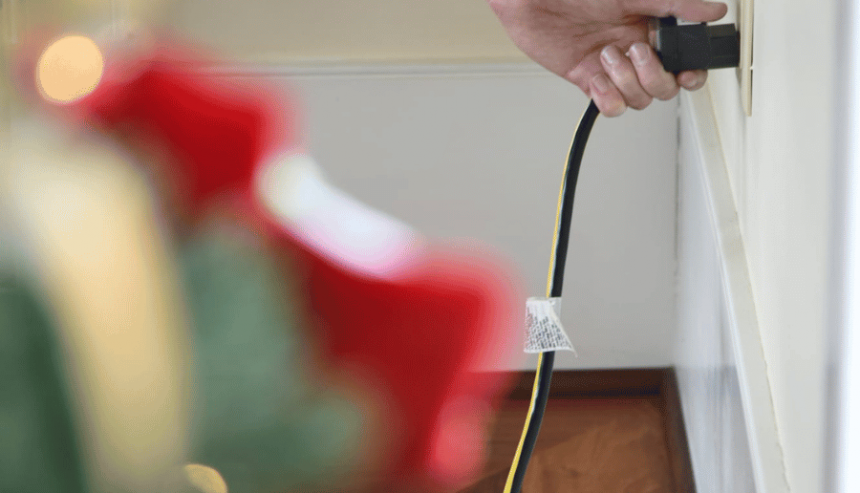
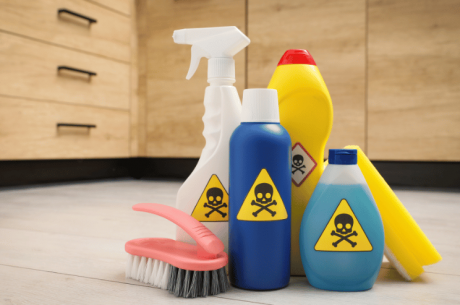

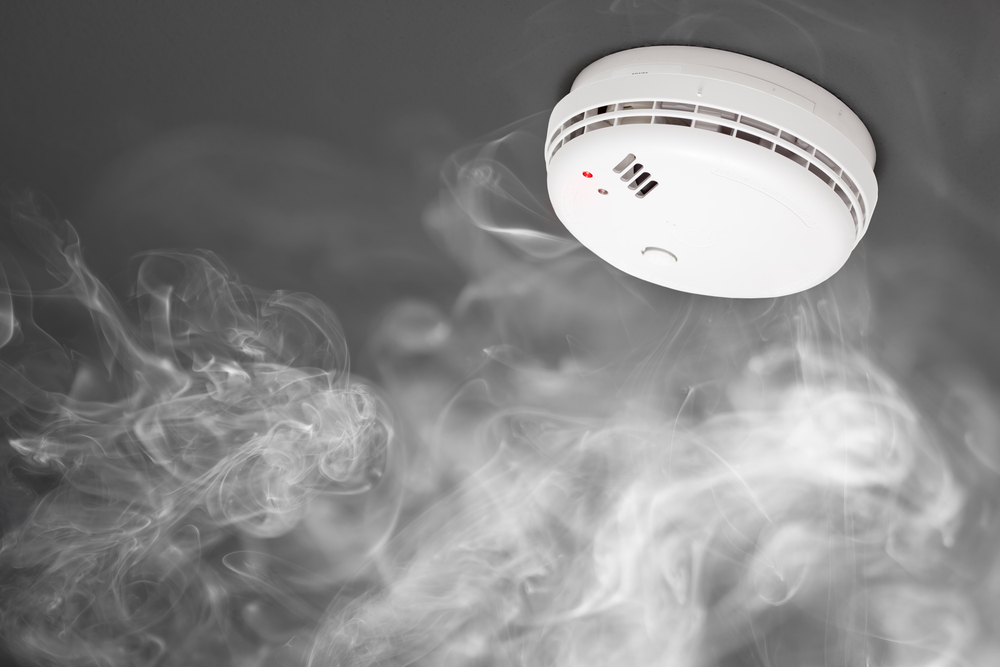
 PuroClean Restoration Services
PuroClean Restoration Services